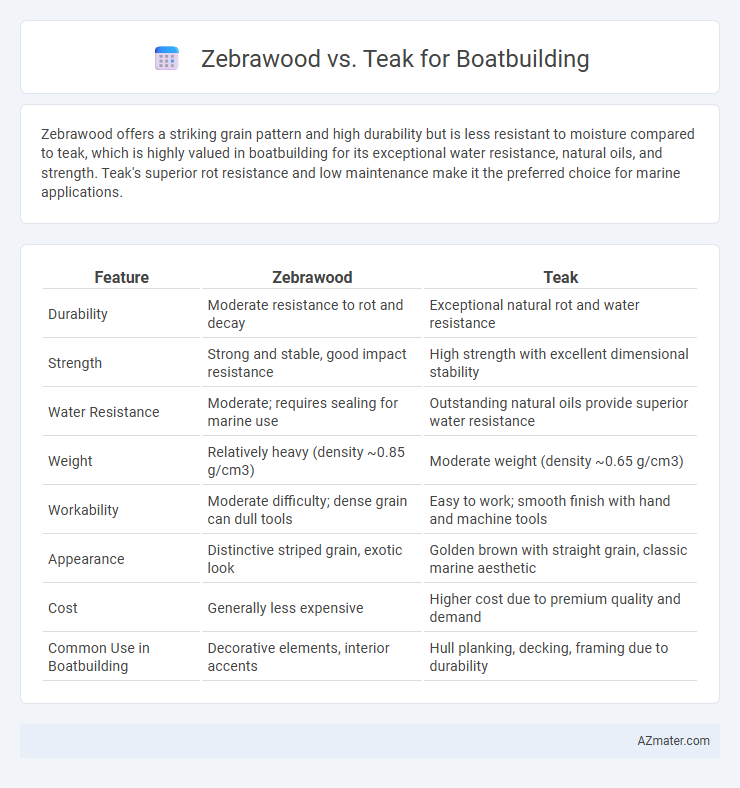Zebrawood offers a striking grain pattern and high durability but is less resistant to moisture compared to teak, which is highly valued in boatbuilding for its exceptional water resistance, natural oils, and strength. Teak's superior rot resistance and low maintenance make it the preferred choice for marine applications.
Table of Comparison
| Feature | Zebrawood | Teak |
|---|---|---|
| Durability | Moderate resistance to rot and decay | Exceptional natural rot and water resistance |
| Strength | Strong and stable, good impact resistance | High strength with excellent dimensional stability |
| Water Resistance | Moderate; requires sealing for marine use | Outstanding natural oils provide superior water resistance |
| Weight | Relatively heavy (density ~0.85 g/cm3) | Moderate weight (density ~0.65 g/cm3) |
| Workability | Moderate difficulty; dense grain can dull tools | Easy to work; smooth finish with hand and machine tools |
| Appearance | Distinctive striped grain, exotic look | Golden brown with straight grain, classic marine aesthetic |
| Cost | Generally less expensive | Higher cost due to premium quality and demand |
| Common Use in Boatbuilding | Decorative elements, interior accents | Hull planking, decking, framing due to durability |
Introduction: Why Wood Choice Matters in Boatbuilding
Choosing the right wood in boatbuilding is crucial for durability and performance, with Zebrawood and Teak being top contenders due to their strength and resistance to water damage. Zebrawood offers a unique aesthetic with its striking grain patterns and high hardness, ideal for visible, decorative elements on boats. Teak is renowned for its natural oils that provide exceptional resistance to rot, mold, and marine organisms, making it a preferred option for structural components and decking in marine environments.
Overview of Zebrawood and Teak
Zebrawood features a distinctive striped grain, high density, and natural resistance to rot and pests, making it suitable for decorative boat components, though less common for full marine structures. Teak is renowned in boatbuilding for its exceptional durability, natural oils that resist water, decay, and fungi, and its ability to withstand harsh marine environments over time. Both woods offer unique aesthetic and functional qualities, with teak preferred for structural elements and zebrawood often chosen for ornamental details.
Physical Properties Comparison
Zebrawood exhibits a high density of approximately 720 kg/m3, providing excellent strength and durability, while teak's density ranges between 610 to 660 kg/m3, making it slightly lighter but still robust. Teak has superior natural oil content, granting exceptional water resistance and decay resistance crucial for marine environments, whereas Zebrawood requires treatment to enhance its moisture protection. Both woods have similar hardness values, with Zebrawood averaging 1570 on the Janka hardness scale and teak around 1155, influencing their wear resistance and longevity in boatbuilding applications.
Durability and Resistance to Water
Zebrawood and teak are popular choices in boatbuilding due to their exceptional durability and water resistance. Teak contains natural oils that provide superior protection against rot, mold, and water damage, making it highly resistant in marine environments. Zebrawood offers good hardness and moderate water resistance but requires proper sealing and maintenance to match teak's long-term durability on boats.
Workability and Ease of Use
Zebrawood offers moderate workability with its coarse texture and interlocking grain, requiring sharp tools to prevent tear-out during boatbuilding. Teak is highly favored for ease of use due to its smooth grain, natural oils, and resistance to warping, making it easier to plane, saw, and fasten. Both woods provide durability, but teak's superior dimensional stability and workability make it a preferred choice for intricate marine applications.
Aesthetic Appeal and Grain Patterns
Zebrawood features striking, contrasting dark stripes on a pale yellow to light brown background, creating a bold, exotic aesthetic that stands out in boatbuilding projects. Teak offers rich golden-brown hues with a smooth, even grain accompanied by subtle rays and a natural luster, providing a classic, timeless elegance favored in marine environments. Both woods exhibit exceptional durability, but Zebrawood's dramatic grain patterns appeal to those seeking unique visual impact, while Teak's consistent color and texture enhance traditional nautical designs.
Maintenance Requirements
Zebrawood requires frequent sealing and oiling to prevent moisture damage and maintain its vibrant striped appearance, making its maintenance more intensive compared to teak. Teak's natural oils provide exceptional resistance to water, rot, and pests, significantly reducing the need for regular upkeep and making it a preferred choice for boatbuilding. Both woods benefit from periodic cleaning, but teak's durability and lower maintenance demands contribute to longer-lasting performance in marine environments.
Cost and Availability
Zebrawood is generally more expensive and less readily available than teak, making it a less common choice for boatbuilding despite its striking grain and hardness. Teak offers a better cost-to-availability ratio due to its widespread use in marine applications and sustainable plantations, resulting in more consistent supply and competitive pricing. The durability and natural oils in teak also reduce maintenance costs over time, enhancing its value for boat builders prioritizing long-term investment.
Environmental Impact and Sustainability
Zebrawood, sourced primarily from West Africa, faces concerns due to deforestation and limited replanting efforts, making its sustainability status less favorable compared to teak. Teak, widely grown in managed plantations across Southeast Asia, offers a more sustainable option with certification programs like FSC ensuring responsible harvesting and regrowth. The environmental impact of zebrawood includes habitat disruption and higher emissions from longer transport routes, whereas teak plantations promote soil conservation and carbon sequestration, supporting eco-friendly boatbuilding choices.
Final Verdict: Which Wood is Best for Boats?
Zebrawood offers striking aesthetics and moderate durability but lacks the superior water resistance and dimensional stability of teak, making it less ideal for prolonged marine exposure. Teak's natural oils and dense grain provide exceptional resistance to rot, decay, and harsh weather, ensuring longevity and low maintenance in boatbuilding applications. Therefore, teak remains the preferred wood for boats where durability and performance in wet environments are critical.

Infographic: Zebrawood vs Teak for Boatbuilding
 azmater.com
azmater.com